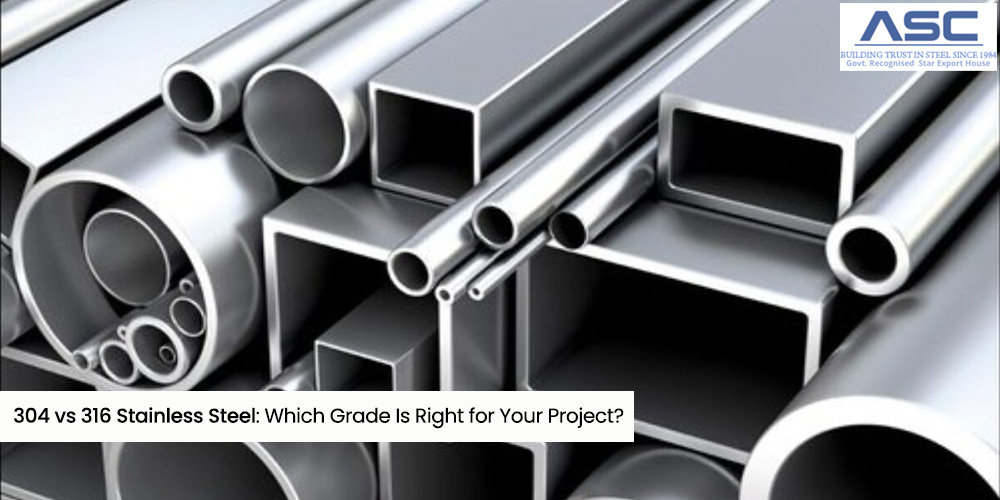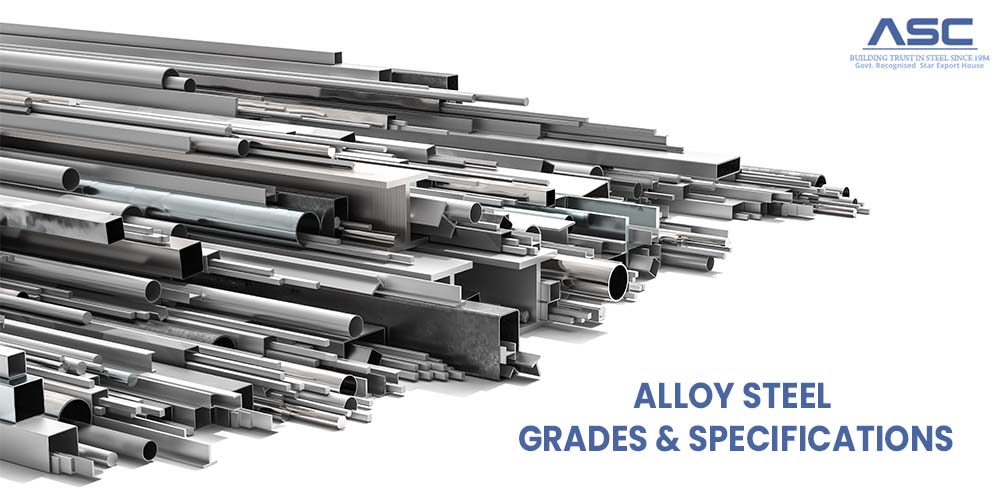304 vs 316 Stainless Steel: Which Grade Is Right for Your Project?
by AMC
Posted on April 25, 2023 at 1:05 PM

Stainless steel is a popular material in various industries because of its corrosion resistance, strength, and durability. Two of the most commonly used grades of stainless steel are 304 and 316. While both of these grades are excellent choices for many applications, they have some key differences that are important to understand.
304 vs 316: What Makes Them So Popular?
The high levels of chromium and nickel in both 304 and 316 stainless steel provide them with exceptional
resistance to heat, abrasion, and corrosion. This makes them ideal materials for a wide range of applications,
from kitchen appliances to chemical processing equipment. In addition to their resistance to corrosion, they
are also known for their clean appearance and overall cleanliness, making them popular choices for
applications where hygiene is important, such as medical and surgical equipment. Overall, the combination of
strength, durability, and cleanliness make 304 and 316 stainless steel highly versatile and reliable materials
for a variety of applications.
Stainless steel is a versatile material that finds use in various industries, and both 304 and 316 grades are
popular choices for their unique properties. 304 stainless steel is the most commonly used grade and is often
referred to as the standard "18/8" stainless due to its composition of 18% chromium and 8% nickel. This grade
is popular for its durability and ease of formability into various shapes, such as sheets, plates, bars, and
tubes. On the other hand, 316 stainless steel is renowned for its superior resistance to chemicals and marine
environments, which makes it a preferred choice among manufacturers. Its ability to withstand harsh conditions
while maintaining its strength and durability makes it an excellent choice for applications where corrosion
resistance is critical.
Properties of 304 Stainless Steel
Chemical Composition of Stainless Steel 304
| % | 304 | 304L | 304H |
| C | 0.0 - 0.07 | 0.0 - 0.03 | 0.04 - 0.08 |
| Mn | 0.0 - 2.0 | 0.0 - 2.00 | 0.0 - 2.0 |
| Si | 0.0 - 1.00 | 0.0 - 1.00 | 0.0 - 1.0 |
| P | 0.0 - 0.05 | 0.0 - 0.05 | 0.0 - 0.04 |
| S | 0.0 - 0.03 | 0.0 - 0.02 | 0.0 - 0.02 |
| Cr | 17.50 - 19.50 | 17.50 - 19.50 | 17.00 - 19.00 |
| Ni | 8.00 - 10.50 | 8.00 - 10.50 | 8.00 - 11.00 |
| Fe | Balance | Balance | Balance |
| N | 0.0-0.11 | 0.0-0.11 | 0.0 - 0.10 |
Physical Properties of Stainless Steel 304
| Property | Value |
| Density | 8.00 g/cm3 |
| Melting Point | 1450 °C |
| Modulus of Elasticity | 193 GPa |
| Electrical Resistivity | 0.72 x 10-6 Ω.m |
| Thermal Conductivity | 16.2 W/m.K |
| Thermal Expansion | 17.2 x 10-6/K |
Mechanical Properties for 304 Stainless Steel Alloys
| Grade | 304 | 304L | 304H |
| Tensile Strength (MPa) | 540 - 750 | 520 - 700 | - |
| Proof Stress (MPa) | 230 Min | 220 Min | - |
| Elongation A50 mm | 45 Min % | 45 Min % | - |
304 Stainless Steel Applications
304 stainless steel is a popular material due to its excellent combination of strength, corrosion
resistance,
and workability. It is used in a wide range of applications across various industries, including:
- Kitchen Appliances: 304 stainless steel is widely used for kitchen appliances like sinks, cookware, and utensils because of its excellent corrosion resistance and clean, attractive appearance.
- Food and Beverage Industry: Due to its non-reactive nature and hygienic properties, 304 stainless steel is commonly used in food processing and beverage production equipment such as tanks, pipelines, and machinery.
- Medical Equipment: 304 stainless steel's resistance to corrosion, ease of cleaning, and excellent sterilization properties make it a popular choice for medical equipment like surgical instruments, hospital bed frames, and dental tools.
- Architectural Features: 304 stainless steel's attractive appearance and durability make it a popular choice for architectural features such as handrails, door and window frames, and trim.
- Automotive Industry: 304 stainless steel's excellent corrosion resistance and strength make it suitable for use in the automotive industry in applications such as exhaust systems and trim.
- Industrial Equipment: 304 stainless steel is used extensively in industrial equipment, including tanks, valves, and pumps, due to its resistance to corrosion and strength.
- Construction: Due to its high strength and corrosion resistance, 304 stainless steel is used in construction for structural support, reinforcing bars, and roofing and siding.
Properties of 316 Stainless Steel
Chemical Composition of Stainless steel 316
| % | 316Ti | 316 | 316L | 316H |
| C | 0.0-0.07 | 0.0-0.03 | 0.04-0.08 | 0.0- 0.08 |
| Mn | 0.0-2.0 | 0-2.0 | 0.0-2.00 | 0.0-2.00 |
| Si | 0.0-1.0 | 0.0-1.00 | 0.0-1.00 | 0.0- 1.00 |
| P | 0.0-0.05 | 0.0-0.05 | 0-0.04 | 0.0-0.05 |
| S | 0.0-0.02 | 0.0-0.02 | 0.0-0.02 | 0.0-0.03 |
| Cr | 16.50-18.50 | 16.50-18.50 | 16.50-18.50 | 16.50- 18.50 |
| Mo | 2.00-2.50 | 2.00-2.50 | 2.00-2.50 | 2.00- 2.50 |
| Ni | 10.00-13.00 | 10.00-13.00 | 10.00-13.00 | 10.50- 14.00 |
| Ti | - | - | - | 0.40- 0.70 |
| Fe | balance | balance | balance | balance |
Physical Properties of Stainless Steel 304
| Grade | 316 Bar and Section (up to 160 mm thick) | 316 Sheet (up to 8 mm thick) | 316 Plate (8 - 75 mm thick) | 316L Bar and Section (up to 160 mm) | 316L Sheet (up to 8 mm thick) | 316 L Plate (8 - 75 mm thick) | 316H Bar (up to 160 mm) | 316Ti Bar (up to 160 mm) |
| Tensile Strength (MPa) | 500 - 700 | 530 - 680 | 520 - 670 | 500 - 700 | 530 - 680 | 520 - 670 | 490 - 690 | 500 - 700 |
| Proof Stress (MPa) | 200 Min | 240 Min | 220 Min | 200 Min | 240 Min | 220 Min | 205 Min | 200 Min |
| Elongation A50 mm | 40 Min % | 40 Min % | 45 Min % | 40 Min % | 40 Min % | 45 Min % | 35 % | 40 Min % |
| Hardness Brinell | 215 Max HB | - | - | 215 Max HB | - | - | - | 215 Max HB |
Physical Properties of Stainless Steel 316
| Property | Value |
| Density | 8.00 g/cm3 |
| Melting Point | 1400°C |
| Modulus of Elasticity | 193 GPa |
| Electrical Resistivity | 0.74 x 10-6 Ω.m |
| Thermal Conductivity | 16.3 W/m.K |
| Thermal Expansion | 15.9 x 10-6/K |
Applications of Stainless steel 316
Stainless steel 316 is a highly corrosion-resistant and durable material that finds applications across a
variety of industries. Here are some common applications of 316 stainless steel:
- Marine Industry: 316 stainless steel's superior corrosion resistance makes it ideal for marine applications like boat fittings, propellers, and offshore oil and gas platforms.
- Chemical Processing: Due to its excellent resistance to chemicals, 316 stainless steel is used in chemical processing equipment such as pipelines, storage tanks, and reactors.
- Medical Implants: 316 stainless steel's biocompatibility and corrosion resistance make it a popular choice for surgical implants and medical devices.
- Food and Beverage Industry: 316 stainless steel's non-reactive nature and high corrosion resistance make it a preferred material for food and beverage processing equipment like tanks, pipes, and valves.
- Aerospace Industry: 316 stainless steel's high strength and corrosion resistance make it suitable for use in aircraft parts and components, including engine parts and fuel tanks.
- Pharmaceutical Industry: 316 stainless steel is widely used in pharmaceutical manufacturing equipment due to its high purity and excellent corrosion resistance.
- Architectural Features: 316 stainless steel's aesthetic appeal and resistance to corrosion make it a popular choice for architectural features like handrails, cladding, and fittings.
304 vs 316 Stainless Steel: Heat Resistance
When it comes to heat resistance, both 304 and 316 stainless steel grades perform well, but they have
different temperature limits due to their composition.
304 stainless steel has a maximum operating temperature of about 870°C (1600°F) and is ideal for
applications that require moderate heat resistance, such as oven components, automotive exhaust systems, and
heat exchangers.
316 stainless steel has a higher melting point than 304 stainless steel, with a maximum operating
temperature of about 1400°C (2550°F). This makes it more suitable for applications that require
high-temperature resistance, such as chemical processing equipment, jet engines, and steam turbines.
The higher nickel and molybdenum content in 316 stainless steel improves its high-temperature performance
compared to 304 stainless steel. The molybdenum in particular enhances its resistance to corrosion by
chloride ions, which can cause pitting and crevice corrosion in high-temperature and high-salinity
environments.
In summary, both 304 and 316 stainless steel grades offer good heat resistance, but the choice of grade will
depend on the specific application and the operating conditions, including temperature, corrosion
resistance, and other factors.
316 vs 304 Stainless Steel: Which is Better?
In summary, both 304 and 316 stainless steel are excellent materials with unique properties and
applications. 304 stainless steel is an excellent choice for many applications, including kitchen
appliances, food processing equipment, and chemical processing equipment. 316 stainless steel is
particularly effective in resisting corrosion in marine environments and is commonly used in boats, docks,
and other marine equipment.
When selecting a grade of stainless steel for your application, it's important to consider the specific
requirements of your project, including corrosion resistance, strength, durability, and heat resistance. By
understanding the differences between 304 and 316 stainless steel, you can make an informed decision about
which grade is best suited for your needs.
.jpg)
Alloy Steel vs. Stainless Steel
Alloy steel is a type of steel that is made by combining two or more different metals or elements to improve its properties.

